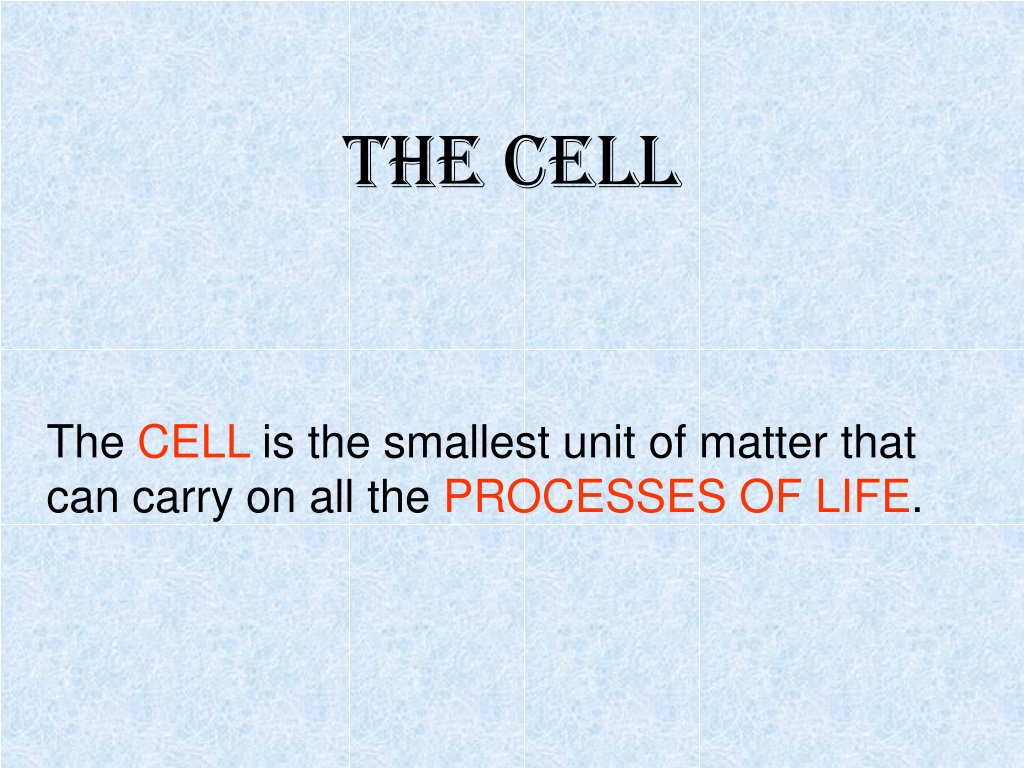Exploring the Fascinating World of Cells and Organelles
Delve into the intriguing realm of cells and organelles, the building blocks of life. Discover the origins of the cell theory, the contributions of pioneers like Anton von Leeuwenhoek and Robert Hooke, and the essential functions of key organelles like the cell membrane, nucleus, mitochondria, and more. Uncover the mysteries of cellular structures and their vital roles in sustaining life.
Download Presentation

Please find below an Image/Link to download the presentation.
The content on the website is provided AS IS for your information and personal use only. It may not be sold, licensed, or shared on other websites without obtaining consent from the author. Download presentation by click this link. If you encounter any issues during the download, it is possible that the publisher has removed the file from their server.
E N D
Presentation Transcript
The Cell The CELL is the smallest unit of matter that can carry on all the PROCESSES OF LIFE.
Anton von Leeuwenhoek Anton von Leeuwenhoek with his hand-held microscope, was the first person to observe and describe Living Cells in the early 17th century
Robert Hooke Robert Hooke looked a thin slices of cork under a microscope. He thought the spaces he saw reminded him of Monks Cells Hence the name cells
Cells All living things are composed of one or more cells. Cells are the basic units of structure and function in an organism. Cells come only from reproduction of existing cells.
Organelles Cells contain a variety of internal structures called ORGANELLES. An organelle is a cell component that PERFORMS SPECIFIC FUNCTIONS FOR THE CELL.
Organelles we need to know Cell membrane Nucleus Mitochondria Chloroplast Ribosomes DNA Cell Wall Vacuole
Learning Check What are Cells? What are organelles? Can you name 8 organelles?
Animal Cells Animal Cells contain the following structures Cell Membranes Mitochondria Nucleus Cytoplasm Only the cell membrane, the cytoplasm and the nucleus can be seen under the light microscope.
Cell Membrane Cell Membranes are made up of phospholipids and proteins The phospholipids and proteins are in constant motion. Membranes are said to be fluid http://library.thinkquest.org/C00453 5/cell_membranes.html
Functions of Cell Membranes Separate the cell organelles and cytoplasm from the outside Semi permeable - allows some molecules freely into and out and others to enter Membranes give some support to the cell Membranes recognise molecules that touch them
Learning Check All cells have a cell membrane. What are its 3 functions? ___________________________________ ___________________________________ ___________________________________
Nucleus A large organelle near the center of the cell is the NUCLEUS. It contains the cell's genetic information It controls the activities of the cell. http://library.thinkquest.org/06aug/01 942/plcells/nuclues.htm
Eukaryotes and Prokaryotes Organisms whose cell contain a nucleus and other membrane-bound organelles are called eukaryotes. Organisms whose cells never contain (or lack) a nucleus and other membrane- bound organelles are called prokaryotes.
Ultra Structure of The Nucleus Nucleolus Nuclear Pore
Whats in a nucleus The nucleus is made up of a double membrane with numerous nuclear pores. These control the movement of substances into and out of the nucleus A nucleolus which contains RNA, DNA, and Proteins and it makes Ribosomes Chromatin which contains DNA that is arranged into chromosomes which stores our genes
Fill in the blanks The control center of the cell is called the ______. It is enclosed by a double membrane called the ___________ __________________. Openings in the nuclear envelope called __________ allow for movement of substances in and out of the nucleus Structures inside the nucleus that contain DNA and proteins are called _____________. Since DNA cannot leave the nucleus, genetic information is copied into molecules of __________ and sent out into the cytoplasm. This information is used to manufacture ________________.
Mitochondria Mitochondria supply energy to the cell respiration Cells with lots of mitochondria produce a lot of energy The inner membranes of the mitochondria produce the energy
Mitochondrion The more folds a mitochondrion has the more energy it produces
Learning Check Label the diagram What is this organelle? Why are they known as powerhouses? What type of cells would have these organelles in large numbers?
Ribosomes Ribosomes can be seen as red dots in this cell Their function is to make proteins
Cytoplasm Cytoplasm is a clear jelly like fluid that fills the cell It contains all the organelles within the cell
Learning Check What is the function of a ribosome? What is the cytoplasm? What is the function of the cytoplasm?
Plant Cells Plant cells also contain other organelles Cell walls Chloroplasts Large Vacuoles
Chloroplasts The function of chloroplasts is Photosynthesis
Ultra structure of the Chloroplast The thylakoids contain the chlorophyll which traps the sun s energy
Cell wall The cell wall is rigid and gives plant cells a very defined shape. The cell wall is composed of cellulose fiber, polysaccharides, and proteins. The function of the cell wall is to support and strengthen the cell http://library.thinkquest.or g/C004535/cell_wall.html
Vacuoles Vacuoles are membrane-bound sacs within the cytoplasm of a cell Vacuoles provide structural support, as well as serving functions such as storage, waste disposal, protection, and growth. Plant cells have large vacuoles http://micro.magnet.fsu.edu/cells/plants/vacuole.html
Learning check 1. What organelle carries out photosynthesis? 2. What type of cells have large vacuoles and cell walls? 3. What is the function of vacuoles? 4. What is the function of cell walls? 5. What makes cells walls rigid?























